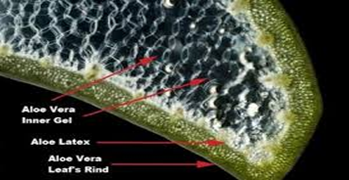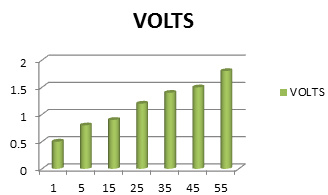
Title: GREEN ELECTRICITY FROM ALOE VERA
Authors: M.MANI TEJA, M.BASHA & N.BALANAIDU, 3rd Year BTech, EEE Department
College: Prakasam Engineering College, Kandukur
1. ABSTRACT:-
Electrical energy places a major role in our daily life. As it places a vital role in our life its consumption also increased. So, different ways are introduced to generate electricity, almost all methods we used conventional energy sources and also some of them are non-conventional type. Due to these ways there are many environmental problems to be faced in practical in conventional. So, in order to overcome all these environmental problems many different non-conventional energy sources are developed, but due these types a lot of problems are taking place. By our project we are introducing new type of non- conventional type energy source. That to generate electricity from Aloe Vera plant. This is very useful in eco-friendly electrical technology. To manufacture new type of electrical batteries by using aloe Vera gel. By further studies of our project it is very useful in upcoming electrical technologies. Not only in the electrical field, but by keeping under consideration of or project GREEN ELECTRICITY FORM ALOVE VERA we can also use Aloe Vera gel in electronic field also in manufacturing eco-friendly products which brings new revelation in both electrical And electronic fields.
2. INTRODUCTION:-
2.1. DIFFERENT WAYS OF ELECTRICTY GENERATION: –
Electrical energy is one of man’s greatest discoveries. It has helped build new civilizations. The large amount of electricity produced has its source in fossil fuels, nuclear fission, water, solar energy and wind. This article will explore the different methods of electricity production.
By burning fossil fuels: – Electricity is produced when the blades of a turbine are moved by enormous amounts of vapor. This vapor is generated by heating a lot of water in huge furnaces. The water is heated by burning fossil fuels like coal, petroleum, and natural gas. Disadvantage is that in this method releases enormous amounts of carbon dioxide in the air, thus severely polluting our atmosphere.
By water: – A popular method to produce electricity, a water dams serves two purposes: restricting water bodies and producing electricity. Water dams use the river water to move turbines, helping them produce electricity. Electricity generated this way helps control air pollution. Disadvantage is that in this however, this method of electricity production adversely affects the ecosystem in the water bodies.
By wind: Electricity is produced when wind energy is converted to electrical energy. Wind mills or wind turbines are used to churn up enormous amounts of wind energy which is then converted into electrical energy. Disadvantage is that wind effect varies time to time form place to place.
By nuclear fission: – Nuclear fission reaction helps produce electricity. Nuclear fission causes a chain reaction where the element Uranium is bombarded by neutrons causing it to split. Every time a Uranium nucleus is split, more neutrons are released, causing more splits in the already split Uranium nuclei. The resultant chain reaction generates a lot of heat which is used to heat water the vapor of which eventually moves turbines to create electricity. Disadvantage is that the wastes release from this will cause effect to pollution.
By bio-waste: – With technological advancements, electricity is also being produced by bio-waste and human wastes. Bio-gas is a typical way of generating electricity. The major problem is that in this method many harmful gases are released which effect human beings.
All these non-conventional energy sources such as solar energy, wind energy, biofuels etc. are takes a vital role in the global growth because conventional energy sources are exhausting rapidly in present days and also due to some disadvantages. Many of them are eagerly waiting to find out the new technique to generate electricity in eco-friendly manner. So, in order to overcome all this problems we are introducing new technique in the generation of electricity by using aloe Vera.
3. ABOUT: –
In fact, we are introducing new technology to produce electricity by using plants. Few plants in the nature have the property of generation of electricity. As like such plants aloe Vera too has electrical properties. This is practically proved by our project GREEN ELECTRICITY. Which is obtained from gelly substance present in its leafs.
3.1. ABOUT ALOE VERA: –
Aloe Vera is a stem less or very short-stemmed succulent plant growing to 60–100 cm (24–39 in) tall, spreading by offsets. The leaves are thick and fleshy, green to grey-green, with some varieties showing white flecks on their upper and lower stem surfaces. Aloe Vera gel consists of around 99.3% of water. The remaining 0.7% is the solids that consist for a large part of polysaccharides of glucose and mannose type. The margin of the leaf is serrated and has small white teeth. The flowers are produced in summer on a spike up to 90 cm (35 in) tall, each flower being pendulous, with a yellow tubular corolla 2–3 cm (0.8–1.2 in) long. Like other Aloe species, Aloe Vera forms arbuscular, mycorrhiza, a symbiosis that allows the plant better access to mineral nutrients in soil.
Aloe Vera or “Aloe Barbadensis” is a plant which originated in North Africa and spread to the fertile lands with mild climate. Its physical aspect is similar to that of the cactus; the thick rind hides a succulent core formed mostly of water. This Aloe Vera plant has a unique quality that can also grow without water in any climatic conditions. Life time of this plant is more when compared with all other plants spices
• Kingdom: Planate
• Clad: Angiosperms
• Order: Asparagales
• Family: Xanthorrhoeaceae
• Subfamily: Asphodeloideae
• Genus: Aloe
• Species: A.vera
• Binomial name: Aloe Vera
3.1.1. PROPERTIES OF ALOE VERA: –
Aloe Vera leaves contain photochemical under study for possible bioactivity, such as acetylated mannans, polymannana, anthraquinone C-glycosides, anthrones, anthraquinones, such as emodin, and various lectins.
3.2. ABOUT ALOE VERA GEL: –
The aloe gel is a thick viscid liquid found in the interior of the leaves. The leaves are commonly used in the treatment of burns and the aloine – a bitter milky yellowish liquid is used as a laxative. The gel contains: 20 minerals (Calcium, Magnesium, Zinc, Chromium, and Selenium), 12 vitamins (A, B, C, E, and folic acid), 20 amino acids from the 22 which are necessary to the human body, over 200 active components including enzymes and polysaccharides. There are 150 nutritional ingredients in Aloe Vera. The ten main areas of chemical constituents of Aloe Vera include: amino acids, anthraquinones, enzymes, minerals, vitamins, lignin, monosaccharide, polysaccharides, salicylic acid, saponins, and sterols.
The essential amino acid is available in Aloe Vera and they include isoleucine, leucine, lysine, methionine, phenylalanine, threonine, valine, and tryptophan. Some of the other non-essential amino acids found in Aloe Vera include alanine, arginine, asparagine, cysteine, glutamic acid, glycine, histidine, proline, serine, tyrosine, glutamine, and aspartic acid.
It also contains Vitamins B1, B2, B3, B5, B6, and B12 along with chorine, calcium, magnesium, zinc, manganese, chromium, selenium.
Additional minerals found in Aloe Vera include copper, iron, potassium, phosphorus, and sodium. Aloe Vera also contains the trace minerals of rhodium and iridium, lignin.
All this shows that aloe Vera plays a vital role in our daily life for may medical purposes. By using our project we prove that aloe Vera is not only useful for medical purposes only but also useful in purposes but also in electrical purposes.
Due to the presence of some of the chemical compounds like zinc, copper, magnesium which are generally used to generate electricity in chemical process in electrolyses.
4. OUR PROJECT – IN DETAIL:-
In order to prove the electrical property of aloe Vera plant we are conducting a small experiment.
To prove that aloe Vera has electrical property.
Aloe Vera plant, needles, single lead copper wire, multi-meter.
In this experiment we took an Aloe Vera plant. To which needles are inserted into its leaf edge on two edges. Each needle is connected by a single lead copper wire. To which one end of copper wire is connected to a multi-meter in order to measure the electricity generated. Due to present of some of chemical properties (Calcium, Magnesium, Zinc, Chromium, Selenium) in aloe Vera leaf helps in generation of electricity. When needles are inserted into the leaf of aloe Vera due to copper and zinc present in the leaf gel due to electrolyses process that take place inside the leaf will generate electricity.
| Sl.no | Time(in minutes) | Voltage(in volts) |
|
1 |
Initially |
0.2 |
|
2 |
5 |
0.46 |
|
3 |
15 |
0.67 |
|
4 |
25 |
0.98 |
For the data in the table the graph is drawn for time and voltage.

The graph shows that as time increases voltage generated
Similarly when some metal is dipped into the aloe Vera gel it too will get electrical properties by reducing its resistive property. This is also proved by our experiment.
Hence the above results show that aloe Vera has electrical properties. Keep under this as considerations we can use aloe Vera gel in may electrical appliances. In different ways like in manufacture of eco-friendly batteries, power plugs …..Etc. It can also be used in manufacture of many electrical products.
5 APPLICATIONS: –
- In the manufacture of eco-friendly electrical appliances.
- Mainly can be used in eco-friendly batteries.
- In electric plugs manufacture.
- Many more electrical eco-friendly products.
6 CONCLUCION: –
By our project we conclude that gel present in leaf of Aloe Vera has electrical properties and can also generate a small amount of electricity as which is illustrated in our project. We can also conclude that keeping this paper in consideration we can bring a new revaluation in eco-friendly electrical product. We can also majorly use Aloe Vera gel in the manufacture of eco-friendly batteries. Even in the eco-friendly electrical products. Not only in electrical products but also in manufacture of eco- friendly electronic products.
7 REFERENCES:-
• http://en.wikipedia.org/wiki/Aloe_Vera
• www.ijsce.org/attachment/pdf
• www.greenelectricity.org/renewable.php
• Aloe Vera: Nature’s Silent Healer Paperback by Alasdair Barcroft (Author), Audun Myskja (Author), Tom Reynolds (Foreword).
